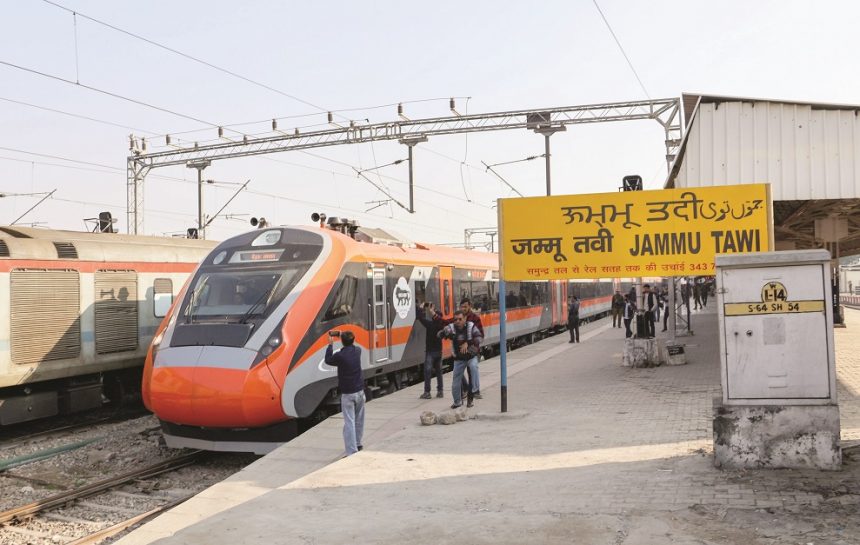After more than a century of dreams, planning, and hard work, Kashmir is finally set to be connected with the rest of India through the railway network.
The Udhampur-Srinagar-Baramulla Rail Link (USBRL) project, one of the most challenging railway projects ever taken up in the country, is nearing its final stretch.
This project not only fulfills an age-old dream of linking Kashmir with India’s railway network but also opens the door for wide-ranging social and economic transformation in the region.
As per Indian Railways, the idea of connecting Kashmir by railway is more than a hundred years old. It was first imagined in the late 19th century during the rule of the Dogra Maharajas in Jammu and Kashmir. On March 1, 1892, Maharaja Pratap Singh laid the foundation stone for a railway line between Jammu and Srinagar. Later, in 1898, Maharaja Ranbir Singh continued efforts to explore the possibility of building a rail link to the Kashmir Valley.
Four different routes were studied to connect Punjab with Srinagar. These included the Banihal route from Jammu, the Poonch route through the Jhelum Valley, the Panjar route from Rawalpindi, and the Abbottabad route through Hazara.
Detailed surveys were carried out for both narrow gauge and broad gauge tracks. However, due to harsh weather, tough terrain, limited resources, and political challenges, the dream remained only on paper.
In 1905, the British government revisited the plan. Maharaja Pratap Singh supported a proposal to build a railway line between Jammu and Srinagar via Reasi, following the historical Mughal Road. This plan also failed to take off due to technical and financial difficulties.
Modern-era efforts begin in 1981
After India gained independence, the idea was revived several times. But it was only in 1981 that the Indian government approved the construction of a rail link between Jammu and Udhampur. This marked the beginning of the modern journey to connect Kashmir with the Indian railway system.
The real breakthrough came in 1994-95, when the central government approved the full-scale USBRL project from Udhampur to Baramulla via Srinagar.
In 2002, it was declared a National Project, giving it top priority and necessary funding. Since then, several milestones have been achieved, connecting various parts of Jammu and Kashmir step-by-step.
Timeline of major milestones
1981 – Jammu to Udhampur rail link approved
1994 – Plan to extend railway to Srinagar announced
1995 – Construction begins on Udhampur to Katra section
1999 – Work begins on Qazigund to Baramulla section
2002 – Katra to Qazigund section work starts
2005 – Jammu-Udhampur section inaugurated
2008-2009 – Sections from Mazhom to Baramulla completed
2013 – Banihal to Qazigund section opened
2014 – Udhampur to Katra section opened
2024 – Banihal to Sangaldan section inaugurated
The final link between Katra and Sangaldan is now in advanced stages of completion, and once done, it will connect Kashmir Valley fully with the Indian railway network for the first time in history.
Socio-economic impact: A game-changer for J&K
The USBRL project is not just about trains and tracks—it’s about changing lives. The impact of this railway line on the economy, employment, connectivity, and national integration is already being felt and will only grow in the years to come.
- Employment Opportunities
The railway project has created thousands of jobs, both directly and indirectly. Over 14,000 people were employed during the construction phase, out of which 65% were locals from Jammu and Kashmir. The Railways also provided government jobs to over 800 individuals whose land was acquired for the project under special policy provisions.
In total, over 5.25 crore man-days of work have been generated, providing a steady source of income to families in the region.
- Skill Development
The USBRL project has also played a major role in training local workers in specialized skills. From tunneling and bridge construction to electrification and track laying, the project used advanced technology. Many local artisans and workers have now become skilled professionals and are employed in other prestigious projects across India.
- Opening Up Inaccessible Areas
Before the start of this project, many remote villages in Jammu and Kashmir were cut off from the rest of the world. These areas had no roads, and people used to walk for hours on footpaths or cross rivers in boats to reach towns.
To make the project possible, over 215 km of approach roads were built, connecting villages such as Guni, Bakkal, Dugga, Surukot, Sawalkote, Sangaldan, Khari, Arpinchala, Bankoot, and many more. In total, about 70 villages with nearly 1.5 lakh people now enjoy road connectivity.
In one remarkable effort, heavy construction machines were airlifted using army helicopters to Surukot in 2010, where even a simple road didn’t exist. A helipad was made by leveling land using just hand tools, and MI-26 helicopters transported machinery weighing over 226 tonnes to these difficult locations.
- Boost to local economy
With new roads and train connectivity, businesses have started to grow in remote areas. Small markets, workshops, tea stalls, and restaurants (dhabas) have come up along the new access routes. Farmers, artisans, and traders now have better access to nearby towns and even national markets. Products like apples, saffron, and handicrafts can now be transported easily, improving income for locals.
- Expected growth in tourism and pilgrimage
Kashmir is one of India’s most beautiful tourist destinations. Better connectivity means more tourists and pilgrims can visit places like the Shri Amarnath Cave temple, Hazratbal shrine, and Charar-e-Sharif with ease. This brings more business to local hotels, taxi services, shops, and restaurants.
- Industrial and agricultural growth
With the railway line, raw materials and finished goods can now move in and out of the valley much faster and at lower cost.
This will help industries grow and encourage investment in small and medium businesses. Farmers will also benefit as their products can now be sent quickly to markets across India and even abroad.
The railway link will bring people from different parts of the country closer together. It will help create better cultural exchange and mutual understanding. As people travel and interact more, it will lead to greater social harmony and integration between Jammu & Kashmir and the rest of India.
7: National Security
The USBRL project also has strategic importance. The railway network will allow for quicker movement of military supplies and personnel in case of emergencies. This adds to national security and brings greater stability to the region.
The railway is electrified, which means less pollution compared to road transport. This shift to greener transport helps protect the fragile environment of the Himalayan region by reducing the carbon footprint.
Hope for Kashmir
The USBRL project is not just a railway project—it is a symbol of hope, development, and unity. For generations, people in Kashmir dreamed of seeing trains running through their valleys. Now, that dream is finally becoming reality.
As the final rail tracks are laid and the last tunnel is completed, a new chapter begins for Jammu and Kashmir. One that promises faster travel, stronger economy, better jobs, more tourists, and most importantly, a deeper connection between Kashmir and the rest of India.








